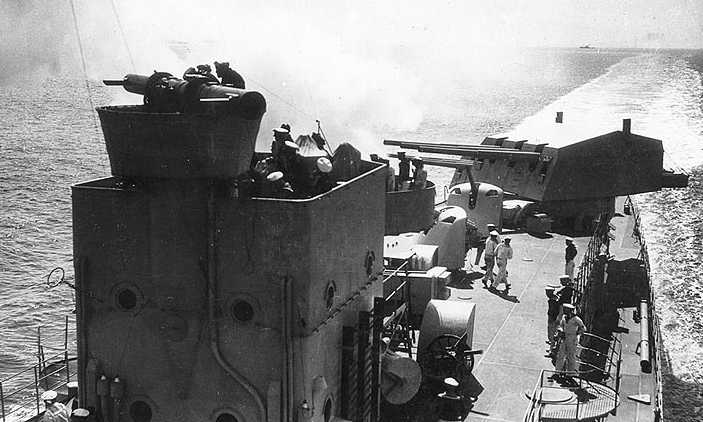
This weapon was used on light cruisers built in the 1920s and 1930s and was slightly more powerful than the 15 cm guns used on battleships and destroyers. The Germans considered this weapon to be too heavy and powerful for any other 15 cm (5.9") application.
The main components of this gun were the loose barrel, a jacket and a breech end-piece with a vertical sliding wedge breech. The breech mechanism was hand worked. The guns were individually sleeved in the three-gun mountings.
All German 15 cm guns had an actual bore diameter of 14.91 cm (5.87 in).
| Designation | 15 cm/60 (5.9") SK C/25 |
|---|---|
| Ship Class Used On | Königsberg, Leipzieg and Nürnberg Classes |
| Date Of Design | 1925 |
| Date In Service | 1929 |
| Gun Weight | 26,389 lbs. (11,970 kg) |
| Gun Length oa | 357.5 in (9.080 m) |
| Bore Length | 337.4 in (8.570 m) |
| Rifling Length | 278.2 in (7.067 m) |
| Grooves | (44) 0.069 in deep x 0.242 in (1.75 mm x 6.14 mm) |
| Lands | 0.177 in (4.5 mm) |
| Twist | Increasing RH 1 in 45 to 1 in 30 |
| Chamber Volume | 1,690 in3 (27.7 dm3) |
| Rate Of Fire | Königsberg and Leipzieg classes: 6 to 8 rounds per minute
Nürnberg: 10 to 12 rounds per minute |
| Type | Separate |
|---|---|
| Projectile Types and Weights 1 2 3 4 | APC L/3,7: 100.3 lbs. (45.5 kg)
HE L/4,4 base fuze: 100.3 lbs. (45.5 kg) HE L/4,5 nose fuze 5: 100.3 lbs. (45.5 kg) HE L/4,5 nose fuze, AA 6: 98.5 lbs. (44.7 kg) HE L/4,5 nose fuze incendiary: 103.6 lbs. (47.0 kg) Illum L/4,3: 90.4 lbs. (41.0 kg) |
| Bursting Charge 7 | APC L/3,7: 2.43 lbs. (1.103 kg) TNT 8 HE L/4,4 base fuze: 8.02 lbs. (3.640 kg) TNT 9 HE L/4,5 nose fuze: 6.620 lbs. (3.914 kg) TNT 10 HE L/4,5 nose fuze incendiary: 6.61 lbs. (3.0 kg) TNT + 4.90 lbs. (2.221 kg) incendiary 11 |
| Projectile Length 12 | APC L/3,7: 21.7 in (55.0 cm)
HE L/4,4 base fuze: 25.8 in (65.5 cm) HE L/4,5 nose fuze: 26.8 in (68.0 cm) HE L/4,5 nose fuze AA: N/A HE L/4,5 nose fuze incendiary: 26.8 in (68.0 cm) Illum L/4,3: 25.4 in (64.5 cm) |
| Propellant Charge 13 14 | All except Illum
40.1 lbs. (18.2 kg) RP C/12 (1150 x 11/4) - or - 43.4 lbs. (19.7 kg) RP C/32 (1150 x 11/5,75) - or - 45.0 lbs. (20.4 kg) RP C/38 (1150 x 10/4,4) Illum
|
| Cartridge Case Size and Weight | 150 x 1192 mm
29.8 lbs. (13.5 kg) |
| Muzzle Velocity | All except Illum: 3,150 fps (960 mps)
Illum: 2,133 fps (650 mps) |
| Working Pressure | 20.5 tons/in2 (3,230 kg/cm2) |
| Approximate Barrel Life | 500 rounds |
| Ammunition stowage per gun 15 16 | Königsberg class: 120 rounds
Leipzieg: 120 rounds Nürnberg: 150 rounds |
- ^The sources below differ regarding the ammunition used for these weapons. For the most part, I have relied upon the data in M.Dv. Nr. 170,30 and in "German Cruisers of World War Two."
- ^All but the AA and Illum projectiles used ballistic caps (windshields).
- ^The tables in M.Dv. Nr. 170,30 show shell weights as 100.3 lbs. (45.5 kg) but the sketches in this same document show the HE nose fuze (Spgr. Bdz) shells as 99.9 lbs. (45.3 kg) and the AA version as 98.5 lbs. (44.7 kg). I have chosen to use the weights in M.Dv. Nr. 170 which are also in M.Dv. Nr. 198.
- ^
Actual German designations APC L/3,7 15 cm Pzgr. L/3,7 (m.Hb) HE L/4,4 base fuze 15 cm Spgr. L/4,4 Bdz (m.Hb) HE L/4,5 nose fuze 15 cm Spgr. L/4,5 Kz (m.Hb) HE L/4,5 nose fuze, AA 15 cm Spgr L/4,5 Kz (m.Hb) – Haube abgeschraubt [unscrewed cap] HE L/4,5 nose fuze incendiary 15 cm Spgr L/4,5 Kz (m.Hb) Br Illumination L/4,3 15 cm Lg L/4,3 - ^German HE Nose Fuzed projectiles with ballistic caps had a rod between the nose of the shell and the fuze to improve performance when striking obliquely. See details on 12.7 cm SK C/34 datapage.
- ^The AA projectile was the same as the standard HE Nose Fuze projectile, but had a time fuze in place of the instantaneous impact fuze and did not use the ballistic cap (windshield). See Anti-Aircraft Projectiles below for a sketch.
- ^Burster weights (reiner Sprengstoff) from M.Dv. Nr. 170,30 and M.Dv. Nr. 198.
- ^The APC burster was made from Fp 15, Fp 5 and Fp 1.
- ^The burster for the HE base fuze projectile was made from Fp 15, Fp 10, Fp 5 and Fp 1.
- ^The burster for the HE nose fuze projectile was made entirely with Fp 1.
- ^Burster for HE base fuze incendiary made from Fp 2 (TNT) and Brandkörper C (incendiary).
- ^APC and HE ballistic caps had a radius of 8.5 calibers. The tangent of the ballistic cap to the shell body was inclined at 5 degrees, which resulted in a projectile with a short overall length.
- ^Propellant weights differ in many references and even in official documents such as the M.Dv. Nr. 170 and M.Dv. Nr. 190 series. This is primarily because different loading weights were used depending upon the powder grain size utilized to make up the charge. The weights in this table are for the powder grains specified for this weapon in M.Dv. Nr. 198.
- ^The propellant charges listed in the above table were noted as Große Gefechtsladung (Large Battle Charge). There were also reduced charges known as Kleine Gefechtsladung (Small Battle Charges ) which gave an MV of 2,740 fps (835 mps).
- ^These are the design figures. "German Warships 1815-1945" says that the actual outfit for Leipzieg and Nürnberg ranged from 120 up to 167 rounds.
- ^Outfit included APC, base fuze HE and nose fuzed HE with and without tracer, plus 250 rounds of illumination for Nürnberg and 120 rounds of illumination for the earlier cruisers. The book outfit for Nürnberg was 30 APC, 50 HE base fuzed and 70 HE nose fuzed. Nürnberg had 16 ready use rounds stored in each gunhouse and a further 10 stored in each handling room.
- Exercise and practice rounds were produced for this weapon.
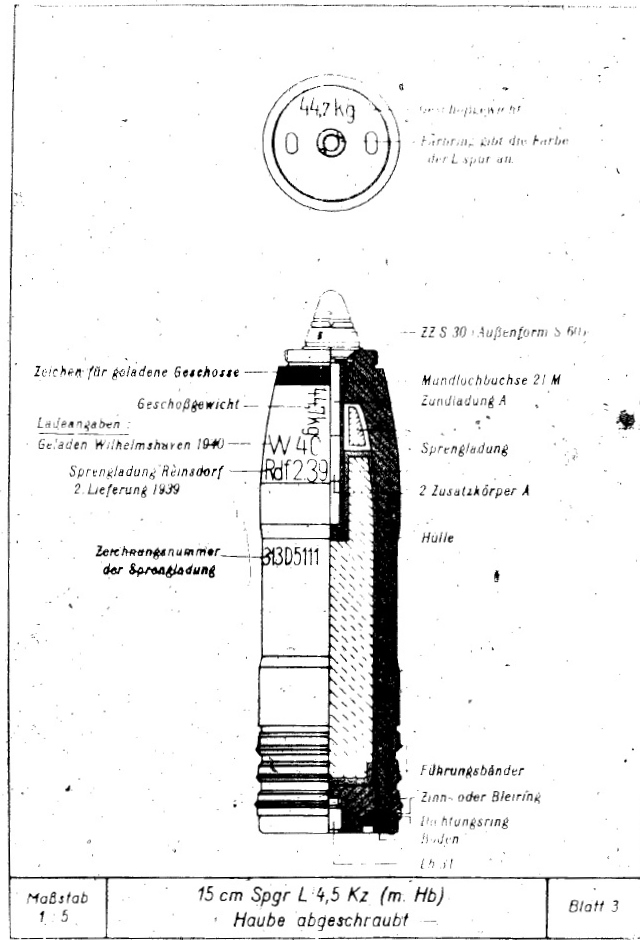
During World War II, German ship-borne naval guns 12.7 cm and larger were supplied with special AA projectiles. As none of the ships with these guns were equipped with AA directors for them, these were only employed for barrage anti-aircraft defense. The AA projectiles were simply the standard HE Nose Fuze projectiles such as the 15 cm Spgr. L/4,5 Kz (m.Hb) with their instantaneous impact fuzes replaced with mechanical time fuzes. In order to allow access for setting the time fuze, these AA projectiles did not use the ballistic cap but instead had the fuzes installed in a small cone-shaped housing which included the time setting dial. The designation for these AA projectiles was the same as for the standard HE projectiles with an added notation to indicate that they lacked the ballistic cap, as can be seen in the sketch at right for the 15 cm Spgr L/4,5 Kz (m.Hb) – Haube abgeschraubt (unscrewed cap).
| Elevation | Distance | Striking Velocity | Angle of Fall |
|---|---|---|---|
| 1.7 degrees | 5,470 yards (5,000 m) | 2,208 fps (673 mps) | 2.2 |
| 5.3 degrees | 10,940 yards (10,000 m) | 1,460 fps (445 mps) | 8.8 |
| 11.5 degrees | 16,400 yards (15,000 m) | 1,043 fps (318 mps) | 23.5 |
| 21.4 degrees | 21,870 yards (20,000 m) | 1,030 fps (314 mps) | 42.0 |
| 36.3 degrees | 27,340 yards (25,000 m) | 1,089 fps (332 mps) | 59.5 |
| 40.0 degrees | 28,106 yards (25,700 m) | --- | --- |
| Range | Thickness |
|---|---|
| 3,500 yards (3,200 m) | 2.36 in (60 mm) |
| 12,250 yards (11,200 m) | 0.79 in (20 mm) |
The above information is from "German Naval Guns: 1939 - 1945" but it is not listed whether this performance is for face-hardened or for homogenous armor plate.
| Designation | Three-gun Turret 1a 2a Königsberg (3) and Leipzieg (3): Drh Tr C/25 Nürnberg (3): Drh Tr C/28 |
|---|---|
| Weight | All except Nürnberg: 301,834 lbs. (136,910 kg)
Nürnberg: 324,410 lbs. (147,150 kg) |
| Elevation | -10 / +40 degrees |
| Elevation Rate | All except Nürnberg: 6 degrees per second
Nürnberg: 6 to 8 degrees per second |
| Train | 360 degrees 3a |
| Train Rate | All except Nürnberg: 6 to 8 degrees per second
Nürnberg: 7.6 degrees per second |
| Gun recoil | 14.6 in (37 cm) |
| Loading Angle | About +3 degrees |
- ^All three cruiser classes had three 3-gun turrets of nearly the same design. The Königsberg class and Leipzieg used the same turret but those on Nürnberg were slightly larger, had thicker frontal (8 cm vs. 3 cm) and rear armor (3.5 cm vs. 2 cm) and slightly more powerful elevation and training motors, which accounts for the weight and speed differences.
- ^The after two turrets on the Königsberg class were offset to allow for better machinery arrangements. The turrets on Leipzieg and Nürnberg were all on the center line. Guns were individually sleeved in all mountings.
- ^These mountings could make one complete revolution in either direction from the mid (fore and aft) position for a total of 720 degrees of train. Firing arc was about -150 / +150 degrees.
- Power to these turrets was part electric, part hydraulic with hand loading and ramming. The magazines were directly under the armored deck, with shells and cartridges stowed in the same spaces. Shells and cartridges were manually carried to the revolving trunk where they were passed through hand troughs which were vertical scuttles holding the shell in the upper chamber and the cartridge in the lower chamber. Each gun was provided with a chain hoist which ran directly between the magazine and guns and there were separate auxiliary bucket hoists at the rear of the main hoists. Shells and cartridges were manually moved from the chain hoists to inclined ready trays and then manually loaded and rammed.
- Each gun was fitted with its own individual gyroscopic firing gear thus eliminating laying errors at the gun.
- Expended cartridge cases for the Drh Tr C/25 turrets were manually pushed out flap ports at the rear of the turret where they were caught by baskets attached to the outside of the turret. The Drh Tr C/28 had an automatic case ejector system which ejected them through an opening in the rear of the turret floor. Rubber mats protected the decks from damage.
- Each gunhouse had a crew of 15 men.
- It is noted in "German Cruisers of World War Two" that the anti-flash arrangements were poor in these ships.
- Gun axes were 61 in (155 cm) apart.
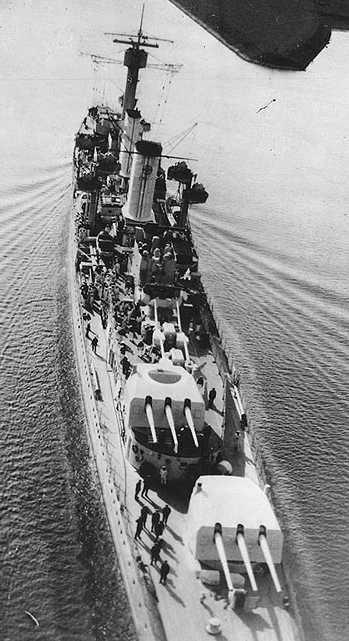
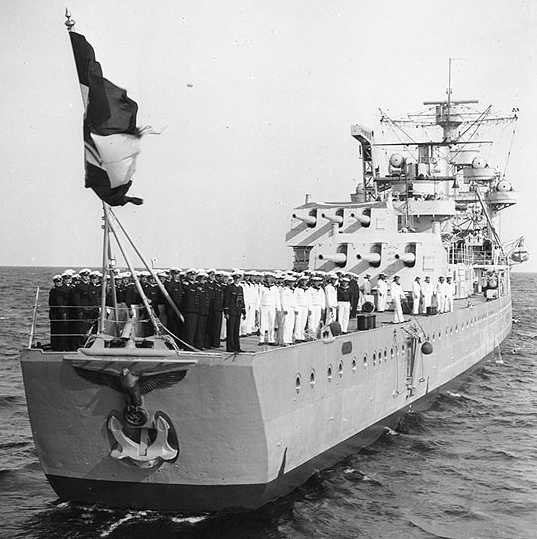
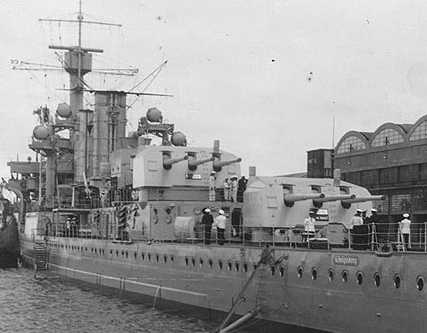

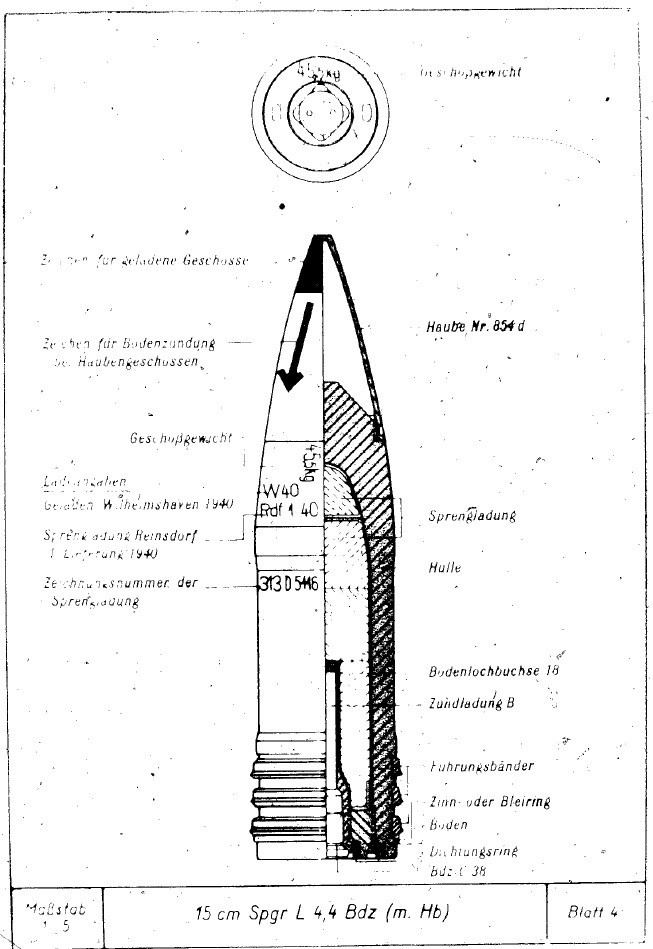
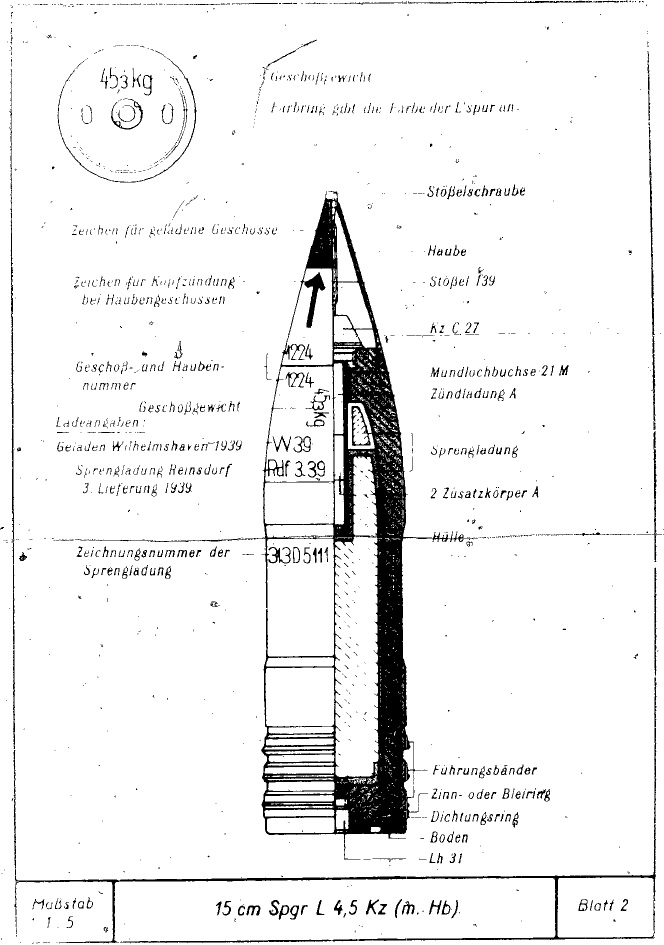
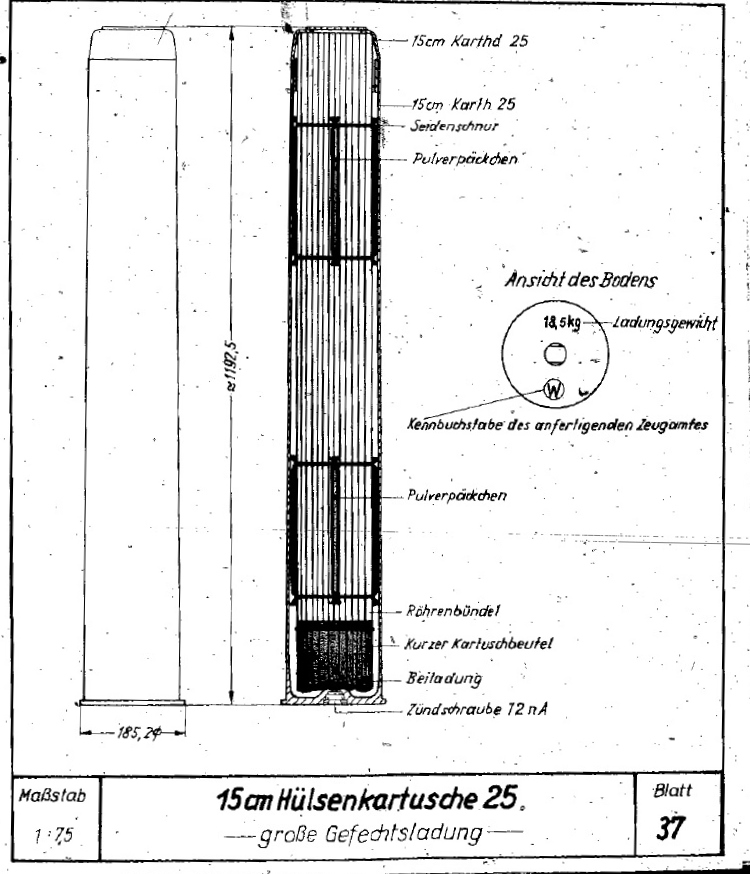
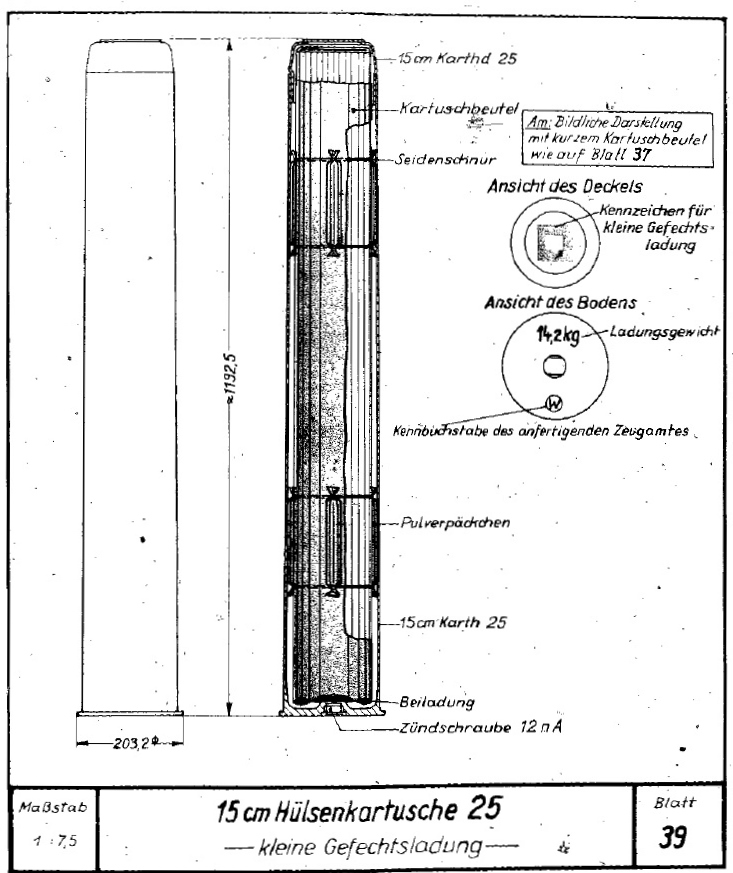
"Naval Weapons of World War Two" by John Campbell
"German Warships 1815-1945" by Erich Gröner
"German Naval Guns: 1939 - 1945" by Miroslaw Skwiot
"German Cruisers of World War Two" and "Lesser Known Warships of the Kriegsmarine No 1: The Light Cruiser Nürnberg"
article in "Warship Volume VI" both by M.J. Whitley
---
"Merkbuch: über die Munition für die 15 cm SK C/25 der Schiffsartillerie" M.Dv. Nr. 170,30 by Oberkommando der Kriegsmarine
"Munitionsvorschriften für die Kriegsmarine - Hülsenkartusche" M.Dv. Nr. 190,4A1 by Oberkommando der Kriegsmarine
"Übersicht über die für die Marinegeschütze und deren Abk K zu verwendende Munition und ihre Einzelteile einschließlich Salut-
und Manöverladungen" M.Dv. Nr. 198 by Oberkommando der Kriegsmarine
17 February 2007 - Benchmark
03 April 2011 - Added cartridge dimensions
20 May 2012 - Added information on ammunition supply
26 February 2019 - Converted to HTML 5 format, reorganized notes, added information and sketches from M.Dv. Nr. 170,30 and M.Dv. Nr. 190,4A1
13 October 2019 - Added section on anti-aircraft projectiles
24 June 2021 - Corrected formatting issue and other minor changes
01 February 2022 - Added MV for HE L/4,5 nose fuze
20 August 2024 - Added burster notes
01 March 2025 - Minor changes
18 April 2025 - Added incendiary projectile and updated propellant types, grains and weights per M.Dv. Nr. 198
